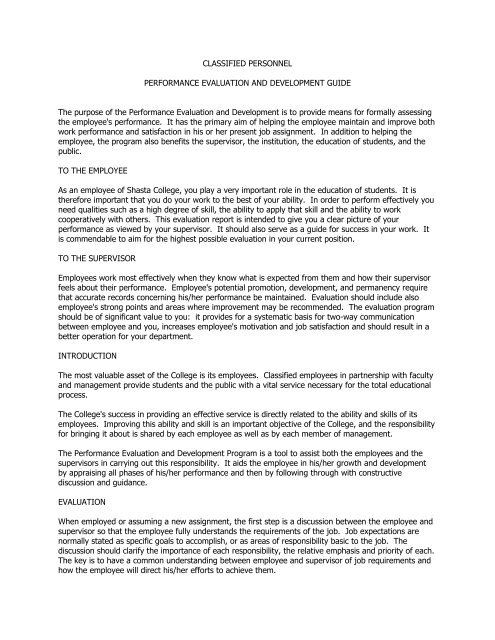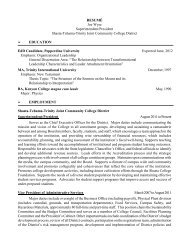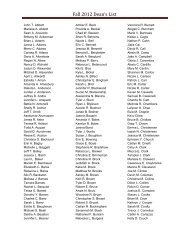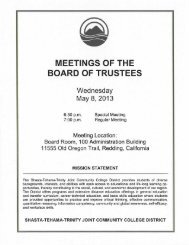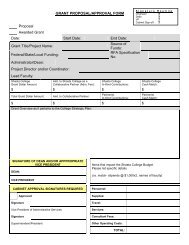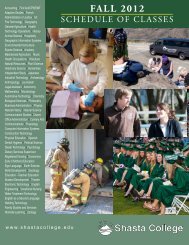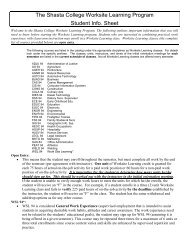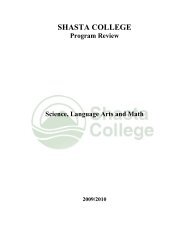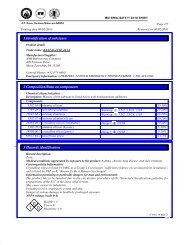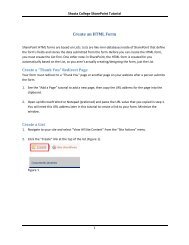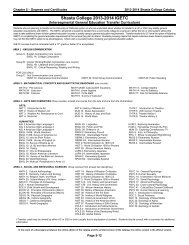Evaluation - Classified Personnel - Shasta College
Evaluation - Classified Personnel - Shasta College
Evaluation - Classified Personnel - Shasta College
You also want an ePaper? Increase the reach of your titles
YUMPU automatically turns print PDFs into web optimized ePapers that Google loves.
CLASSIFIED PERSONNEL<br />
PERFORMANCE EVALUATION AND DEVELOPMENT GUIDE<br />
The purpose of the Performance <strong>Evaluation</strong> and Development is to provide means for formally assessing<br />
the employee's performance. It has the primary aim of helping the employee maintain and improve both<br />
work performance and satisfaction in his or her present job assignment. In addition to helping the<br />
employee, the program also benefits the supervisor, the institution, the education of students, and the<br />
public.<br />
TO THE EMPLOYEE<br />
As an employee of <strong>Shasta</strong> <strong>College</strong>, you play a very important role in the education of students. It is<br />
therefore important that you do your work to the best of your ability. In order to perform effectively you<br />
need qualities such as a high degree of skill, the ability to apply that skill and the ability to work<br />
cooperatively with others. This evaluation report is intended to give you a clear picture of your<br />
performance as viewed by your supervisor. It should also serve as a guide for success in your work. It<br />
is commendable to aim for the highest possible evaluation in your current position.<br />
TO THE SUPERVISOR<br />
Employees work most effectively when they know what is expected from them and how their supervisor<br />
feels about their performance. Employee's potential promotion, development, and permanency require<br />
that accurate records concerning his/her performance be maintained. <strong>Evaluation</strong> should include also<br />
employee's strong points and areas where improvement may be recommended. The evaluation program<br />
should be of significant value to you: it provides for a systematic basis for two-way communication<br />
between employee and you, increases employee's motivation and job satisfaction and should result in a<br />
better operation for your department.<br />
INTRODUCTION<br />
The most valuable asset of the <strong>College</strong> is its employees. <strong>Classified</strong> employees in partnership with faculty<br />
and management provide students and the public with a vital service necessary for the total educational<br />
process.<br />
The <strong>College</strong>'s success in providing an effective service is directly related to the ability and skills of its<br />
employees. Improving this ability and skill is an important objective of the <strong>College</strong>, and the responsibility<br />
for bringing it about is shared by each employee as well as by each member of management.<br />
The Performance <strong>Evaluation</strong> and Development Program is a tool to assist both the employees and the<br />
supervisors in carrying out this responsibility. It aids the employee in his/her growth and development<br />
by appraising all phases of his/her performance and then by following through with constructive<br />
discussion and guidance.<br />
EVALUATION<br />
When employed or assuming a new assignment, the first step is a discussion between the employee and<br />
supervisor so that the employee fully understands the requirements of the job. Job expectations are<br />
normally stated as specific goals to accomplish, or as areas of responsibility basic to the job. The<br />
discussion should clarify the importance of each responsibility, the relative emphasis and priority of each.<br />
The key is to have a common understanding between employee and supervisor of job requirements and<br />
how the employee will direct his/her efforts to achieve them.
Performance <strong>Evaluation</strong> and Development Guide<br />
<strong>Classified</strong> <strong>Personnel</strong><br />
Whenever there is a good reason for the employee and the supervisor to discuss performance, a review<br />
should be held. As an employee, when you have questions or concerns, you should feel free to ask your<br />
supervisor for help and, when necessary, for a review. These ongoing discussions can help you be sure<br />
you are moving in the right direction and that problems are addressed as soon as they arise.<br />
The first performance evaluation for probationary employees will take place not later than 90 days after<br />
initial employment. The last evaluation will be performed during the 8th month of employment. For<br />
employees promoted into a higher classification, the evaluation period is 90 days and 150 days after<br />
initial employment. <strong>Evaluation</strong>s of all permanent employees will be made annually.<br />
When your performance plan period is over, your supervisor will review your accomplishments in your job<br />
and will evaluate and rate your performance.<br />
The following is a sequential procedure each supervisor should follow to accomplish an objective<br />
evaluation:<br />
Ensure that the job description for the position to be rated is current. Keep in mind the duties<br />
and responsibilities of the position as you rate the person on each factor.<br />
The supervisor prepares the Performance <strong>Evaluation</strong> form. This form is self-explanatory. Ensure<br />
that ratings are supported by comments and specific examples in spaces provided.<br />
Front Page:<br />
DEFINITION--List major responsibilities for appraisal period.<br />
OVER-ALL PERFORMANCE RATING--Using the job description and the employee's performance of the<br />
assigned duties, the immediate supervisor rates the overall performance. The rating should reflect<br />
individual ratings for each performance factor on pages two and three.<br />
Supporting observation, i.e. comments and specific examples must be provided for all ratings.<br />
If the supervisor asks other management for comments then check appropriate line (appraisal made<br />
by ...). When a "Fair" or Unsatisfactory" rating is given, the employee should be re-evaluated within 90<br />
days to determine whether there has been improvement.<br />
RECOMMENDATION--Check appropriate line and complete as indicated.<br />
2
Performance <strong>Evaluation</strong> and Development Guide<br />
<strong>Classified</strong> <strong>Personnel</strong><br />
Pages Two and Three:<br />
Rate individual factors according to rating scale shown at top of page two. In cases where continued<br />
performance is "Unsatisfactory", the immediate supervisor should consult with the vice president to<br />
determine the appropriate action to be taken.<br />
Provide appropriate comments, examples and specific accomplishments of the employee for all ratings.<br />
Page Four:<br />
Self-explanatory and should be completed with comments as appropriate.<br />
DEVELOPMENT--The Employee/Supervisor discussion should now be held.<br />
The real payoff in the evaluation process comes through the action taken to assist the employee to<br />
develop himself/herself into a more useful member of the employee group. The primary purpose of the<br />
program is to assist the employee in his/her growth and development. The appraisal should therefore be<br />
used to this end.<br />
Most employees want to know how they are getting along--to talk frankly with someone in authority<br />
about their jobs. Such discussions, properly conducted, will build better understanding between<br />
supervisor and employee. This is especially true if the employee is told about his/her strong points as<br />
well as the ones that need improvement.<br />
In cases where the employee has made significant accomplishments beyond the assigned job, the<br />
supervisor should record and consider them in assessing the overall performance.<br />
As a result of the periodic reviews during the year, the evaluation and the rating should be what is<br />
expected. But if the employee disagrees, the supervisor should be told. It is important to discuss the<br />
reasons for disagreement.<br />
After discussing the rating for the previous period, the supervisor will discuss the strengths--the things<br />
the employee does that have the most positive effect on performance--and will suggest some areas<br />
where extra effort could have a significant influence on the employee’s ability to improve performance.<br />
The employee should consider these as constructive suggestions for the future rather than criticism of<br />
the past.<br />
At the conclusion of the interview, the employee will have the opportunity to review the completed<br />
evaluation form.<br />
After the interview, the document will be sent for review and comment to the appropriate vice president.<br />
It then will be filed in the employee’s personnel file.<br />
DEVELOPMENT<br />
An important responsibility of every supervisor is to provide career counseling and development guidance<br />
to each employee.<br />
The completed evaluation form may in itself indicate the areas for development. Awareness of career<br />
interests will assist the supervisor to provide meaningful guidance to the employee.<br />
3
Performance <strong>Evaluation</strong> and Development Guide<br />
<strong>Classified</strong> <strong>Personnel</strong><br />
SUMMARY<br />
The Performance and <strong>Evaluation</strong> program is designed to help assure that the employee is treated as an<br />
individual in his/her career with <strong>Shasta</strong> <strong>College</strong>.<br />
It is intended to accomplish three specific goals:<br />
Let the employee know what's expected in the present job and ways to do that job better.<br />
Rate performance on the basis of actual contributions to the <strong>College</strong>.<br />
Help the employee develop talents to achieve maximum potential.<br />
APPLICATION--SUPERVISION<br />
In order to fulfill the objectives of the Performance <strong>Evaluation</strong> and Development, it is necessary that the<br />
results of the evaluation accurately reflect the individual's performance and that these results are<br />
discussed with the employee in an objective manner.<br />
PLANNING FOR DISCUSSION--The Supervisor who conducts the discussion should prepare beforehand.<br />
He/she should carefully plan an approach best suited to the individual. He/she should make every effort<br />
toward a constructive discussion--one that will foster mutual understanding and respect.<br />
The time should be selected so that the discussion will not be hurried or interrupted. The discussion<br />
should be conducted in private and the employee put at ease.<br />
THE DISCUSSION--Be sure the employee understands the real purpose of the Performance <strong>Evaluation</strong><br />
and Development Program, and how appraisals are made. He/she should be told that this particular<br />
discussion is a part of that program.<br />
In discussing the appraisal, show appreciation for each element of good performance. Explain fully the<br />
reason for the appraisal on each point. Do not dwell at length on past failures, if any, unless there is a<br />
good reason for doing so. Give the employee every opportunity to ask questions and express his/her<br />
own feelings.<br />
Guide the discussion into suggestions and plans for improvement and progress. A successful discussion<br />
of the appraisal will inspire in the employee the feeling that his/her supervisor is interested in him/her as<br />
an individual and in helping him/her improve.<br />
Ask the employee to acknowledge that the performance evaluation discussion was held. Complete the<br />
section and provide other comments if any. Indicate comments by the employee. Sign the form and<br />
forward it to the appropriate vice president.<br />
4
Performance <strong>Evaluation</strong> and Development Guide<br />
<strong>Classified</strong> <strong>Personnel</strong><br />
APPENDIX A<br />
OVER-ALL PERFORMANCE LEVEL DEFINITION:<br />
The following phrases are descriptive of the various performance areas. The performance areas are<br />
meant to define overall level of performance. Supervisors should review the various descriptive phrases<br />
and decide which group of phrases best describes the overall performance of the rated employee.<br />
PERFORMANCE UNSATISFACTORY:<br />
Use of this performance area implies that the employee:<br />
Has been on the job long enough to show better performance and should be told immediate<br />
improvement is needed to avoid corrective action.<br />
Is creating a morale problem with those who have to help carry the load (including yourself).<br />
Doesn't seem to have the drive or the know-how to do the job and might be better off in some<br />
other job.<br />
More than likely recognizes that the job is not getting done satisfactorily.<br />
Just doesn't seem to grasp the situation no matter how many times you explain things.<br />
Has had adverse comments from outsiders concerning performance.<br />
Seems to make one goof after another, some of them repeats. Apparently does not have the<br />
background to grasp the work.<br />
PERFORMANCE FAIR:<br />
Use of this performance area implies that the employee:<br />
Is performing not really poorly, but if all employees were of this performance level, the area<br />
would be in trouble.<br />
Needs to improve, but in the meantime, the job usually gets done.<br />
Is “carried” by others on occasion.<br />
Can't always be depended on to complete assignments without frequent reminding and checking<br />
on progress.<br />
Has not been on the job long enough to have developed thorough familiarity and competence in<br />
all phases of position to which exposed.<br />
5
Performance <strong>Evaluation</strong> and Development Guide<br />
<strong>Classified</strong> <strong>Personnel</strong><br />
PERFORMANCE SATISFACTORY:<br />
Use of this performance area implies that the employee:<br />
Is doing a full, complete and satisfactory job. The performance is what is expected of a fully<br />
qualified and experienced person in the assigned position.<br />
Does not need or require significant improvement. If there is improvement, it is a plus factor for<br />
the department's effectiveness. If not, there is no reason to complain.<br />
Is good and contributes to total departmental performance.<br />
Almost never get complaints form others with whom the employee interacts. Errors are few and<br />
seldom repeated.<br />
Demonstrates a sound balance between quality and quantity.<br />
Does not spend undue time on unimportant items; neglecting problems or projects that should<br />
have priority.<br />
Makes inputs you can quote with confidence.<br />
Requires only normal supervision and follow-up and almost always completes the work or<br />
projects on schedule.<br />
Has shown competence in all phases of position to which exposed.<br />
Is a good solid member of the team and can perform any kind of assignment within the scope of<br />
the grade.<br />
PERFORMANCE ABOVE AVERAGE:<br />
Use of this performance area implies that the employee:<br />
Meets all and exceeds many position requirements on a continuing basis even on some of the<br />
most difficult and complex parts of the job.<br />
Regularly accomplishes more than expected.<br />
Often provides "extras" in performance of assigned responsibilities and is a self-starter.<br />
Normally does a thorough and complete job with minimum direction.<br />
Thinks beyond the details of the assignment and works toward the overall objectives of the<br />
department.<br />
Is usually able to take on some extra projects and tasks without defaulting in any of the regular<br />
activity fields.<br />
Is considered promotable in the near future based on demonstrated performance.<br />
6
Performance <strong>Evaluation</strong> and Development Guide<br />
<strong>Classified</strong> <strong>Personnel</strong><br />
PERFORMANCE SUPERIOR:<br />
Use of this performance area implies that the employee:<br />
Significantly exceeds all position requirements on a continuing basis even on the most difficult<br />
and complex parts of the job and seizes the initiative in development and in implementation of<br />
challenging work goals.<br />
Demonstrates a knowledge that normally can be gained only through long periods of experience<br />
in the particular type of work.<br />
Thoroughly completes each project or job tackled with little or no supervision, including those<br />
that are newly assigned.<br />
Regularly takes on additional projects and tasks without defaulting on the normal activity fields.<br />
Shows exceptional authority of knowledge.<br />
Does most of his/her own advance planning, anticipates problems and takes appropriate action.<br />
Makes contributions outside the scope of the job and recognizes and anticipates the impact of<br />
actions taken.<br />
Is ready for promotion.<br />
HINTS ABOUT APPRAISAL:<br />
Even with a definition of the rating terms, which may help in recognizing the various degrees of<br />
performance, the supervisor should be aware of the type of error that may creep into the appraisal and<br />
influence otherwise sound judgment. Supervisors need to be alert to the following defects in appraisals<br />
which experience shows are the most often encountered.<br />
1. The leniency tendency is the most common appraisal error and results from the desire to<br />
protect the person being appraised, or perhaps the supervisor may not understand good<br />
appraisal methods, or feels that a group rated high reflects credit on the supervisor. The<br />
supervisor may also be influenced more by personality and individual potential than by<br />
contributions actually made.<br />
2. The halo effect results from giving undue weight or influence to a recent incident or<br />
accomplishment rather than making the appraisal from observation and experience covering<br />
the whole period.<br />
3. The critical incident type of appraisal reflects situations where undue emphasis is given to a<br />
recent error or unfortunate incident.<br />
4. The central tendency results from being unwilling to judge that some persons are more or<br />
less effective than others. The appraiser likes to consider that people are all about average<br />
rather than determining which are exceptionally good or exceptionally poor. This may<br />
indicate an actual lack of knowledge about performance, or it may reflect a desire to take the<br />
easy way out, to play safe, or fail to take adequate time to analyze and make a good<br />
judgment.<br />
7
Performance <strong>Evaluation</strong> and Development Guide<br />
<strong>Classified</strong> <strong>Personnel</strong><br />
5. The severe tendency occurs when the supervisor has very high and rigid standards and<br />
perhaps fears being put in a bad light if the appraisal rating is too high.<br />
6. Constant ratings are similar to central ratings but may be reflected in either high, low or<br />
central ratings. Such appraisals usually are made by those who place a special premium on<br />
length of service, thus penalizing short service, or may result from the feeling that a person<br />
in a high-grade position must be doing an extremely effective job and that a person in a lowgrade<br />
position must be less effective.<br />
8
Name:<br />
SHASTA COLLEGE<br />
- Confidential -<br />
<strong>Classified</strong> <strong>Personnel</strong><br />
PERFORMANCE EVALUATION AND DEVELOPMENT<br />
Annual Interim Probationary<br />
<strong>Evaluation</strong> period covered:<br />
From:<br />
To:<br />
Position Title:<br />
Employment date:<br />
Time in present position:<br />
Department/Division:<br />
DEFINITION Position: Duties and Responsibilities (describe briefly major objectives of this job)<br />
Overall Performance RATING – Summarize by rating the employee against the total requirements of his/her present job:<br />
Supporting Observation:<br />
* Superior performance<br />
One of the very best<br />
Appraisal made by:<br />
Immediate Supervisor<br />
Group Appraisal,<br />
including Supervisor *<br />
Conference with employee<br />
held on:<br />
* Above Average<br />
Consistently well above what is expected<br />
* Satisfactory<br />
Meets the requirements of the job<br />
* Fair<br />
Generally okay, but some improvement needed<br />
* Unsatisfactory<br />
Not up to requirements of the job<br />
* These ratings must be substantiated by supporting<br />
observation and examples.<br />
* Appraised also by:<br />
For factors:<br />
RECOMMENDATION:<br />
Retention in this position<br />
Employee Comments: yes attached none<br />
Placement on the next salary step:<br />
Non-retention<br />
For office use only (payroll data):<br />
Evaluated by:<br />
Immediate Supervisor Signature<br />
Date<br />
Classification: Range<br />
Current Step<br />
* Next Step (if due)<br />
$<br />
$<br />
$<br />
Note:<br />
* To be granted if due and performance satisfactory or better<br />
Page 1 Employee Signature Date
PERFORMANCE EVALUATION (To be based on appropriate list of job duties and responsibilities developed from Job Description<br />
and assignment which provide a common understanding of the job objectives.)<br />
Rating Scale<br />
1. Outstanding – Superior performance; significantly exceeds job requirements.<br />
2. Above Average – Consistently well above what is expected.<br />
3. Satisfactory – Meets the requirements of the job. Properly trained and qualified employees are<br />
expected to meet this level.<br />
4. Fair – Improvement needed.<br />
5. Unsatisfactory – Not up to required standards of the job; performance unacceptable.<br />
Performance Factors Performance Level Supporting Observation<br />
1 2 3 4 5<br />
1. JOB KNOWLEDGE<br />
Understanding of all<br />
phases of his/her work<br />
and related matters.<br />
Knowledge applied<br />
with respect to total<br />
job.<br />
1<br />
2<br />
3<br />
4<br />
5<br />
2. QUALITY OF WORK<br />
Thoroughness,<br />
neatness, accuracy,<br />
meeting accepted<br />
expectations of the<br />
position (Acceptability<br />
of work produced).<br />
3. JOB EFFORT<br />
Work output – relative<br />
to schedules,<br />
expectations – under<br />
normal conditions<br />
(Amount of acceptable<br />
work).<br />
4. INITIATIVE<br />
Self starting and acting<br />
on own. Amount of<br />
direction needed.<br />
1<br />
2<br />
3<br />
4<br />
5<br />
1<br />
2<br />
3<br />
4<br />
5<br />
1<br />
2<br />
3<br />
4<br />
5<br />
Page 2 Employee Signature Date
Performance Factors Performance Level Supporting Observation<br />
1 2 3 4 5<br />
5. JUDGMENT<br />
Adequacy of judgment<br />
applied as required by<br />
job responsibilities.<br />
1<br />
2<br />
3<br />
4<br />
5<br />
6. COOPERATION and<br />
Support to others<br />
relative to job<br />
responsibilities.<br />
Effectiveness in working<br />
with others. Attitude<br />
towards work.<br />
1<br />
2<br />
3<br />
4<br />
5<br />
7. ATTENDANCE 3<br />
4<br />
5<br />
8. SAFETY<br />
Understanding and<br />
application of safe<br />
practices – observes<br />
safety rules.<br />
3<br />
4<br />
5<br />
Following items only for<br />
SUPERVISORY <strong>Personnel</strong> evaluation<br />
9. LEADERSHIP<br />
Ability and effectiveness<br />
as a supervisor.<br />
Ability to lead and train<br />
others and to get<br />
results through<br />
teamwork.<br />
1<br />
2<br />
3<br />
4<br />
5<br />
10. PLANNING &<br />
ORGANIZATION<br />
Organizes and plans<br />
work effectively; makes<br />
sound decisions; acts<br />
on basis of facts; plans<br />
for long-range results.<br />
Analytical ability; ability<br />
to communicate.<br />
1<br />
2<br />
3<br />
4<br />
5<br />
Page 3 Employee Signature Date
Employee’s major work-related STRENGTHS<br />
Employee’s major work-related areas that need strengthening:<br />
Additional achievements and qualifications – describe other factors not brought out in previous sections, thought to be<br />
important to his/her effectiveness in current job.<br />
DEVELOPMENT Discussion Summary:<br />
Concerning employee’s development in his/her present assignment:<br />
a) On what factors was it agreed to try and improve:<br />
b) What development activities were planned with and for the employee to help him/her develop him/herself on these factors:<br />
c) Employee’s desires, job preferences, attitude, self-development activities, etc.:<br />
COMMENTS:<br />
Potential: How would you evaluate this person’s potential--the capacity for advancement (Consider basic abilities, interest in<br />
advancement, previous training, knowledge of the job, proficiency in skills and techniques, etc.) For what particular jobs and<br />
when ready<br />
Supporting Observation:<br />
Employee comments, if any: ____________________________________________________________________________<br />
____________________________________________________________________________________________________<br />
(Use additional pages as needed.)<br />
Discussed with the employee by:<br />
This evaluation and development report<br />
has been discussed with me.<br />
Page 4<br />
Signature Date Employee Signature Date<br />
NOTE: Signature of employee acknowledges only that the evaluation was discussed and that a copy has been reviewed.<br />
The signature is not an indication that the employee concurs with the contents.<br />
Adopted by Board<br />
4/26/78


